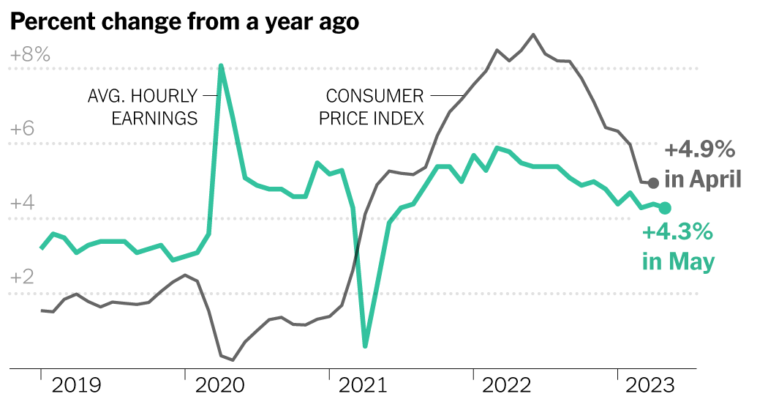
[ad_1]
Federal Reserve officials have signaled that they could hold rates steady at their upcoming meeting in June — pausing after a string of 10 straight rate increases to give themselves time to see how the economy is shaping up. Fresh jobs data released Friday could help to inform policymakers as they try to decide whether this is the right moment to take a break.
Unfortunately for central bankers, they made for a complicated picture: While unemployment climbed and wage growth slowed in May, evidence of the cool-down the Fed has been waiting for, actual job gains were much stronger than economists had expected.
Central bankers lifted interest rates to a range of 5 to 5.25 percent as of last month, up sharply from near-zero at the start of 2022. But they have been signaling that it could soon be appropriate to take a break from increasing rates so that they can assess how the economy is absorbing the big policy changes they have already made and the consequences of other developments, including the fallout from recent bank turmoil.
Higher interest rates cool the economy by making it more expensive to borrow to buy a house or finance a car purchase, but they take time to have their full effect. In response to steeper borrowing costs, businesses gradually pull back on expansion plans and slow hiring, which then feeds into weaker wage growth and a slower economy overall.
That is why job market data are so critical. They are a referendum on how well policy is working to cool the economy, and they hint at whether inflation is likely to slow down. Officials have been worried that rapid wage growth could prod companies to keep increasing prices rapidly as they try to prevent heftier wage bills from eating into profits.
Friday’s jobs market data offered both good and bad news for policymakers. The unemployment rate climbed to 3.7 percent, compared to 3.4 percent in the previous reading, and wage growth slowed slightly. Yet employers added 339,000 jobs in May, vastly more than economists had expected and a pickup from the previous month.
Those conflicting signals — of softening on one hand and resilience on the other — owed in part to different results coming from the two different surveys that are used within the monthly employment report. But the job market split-screen could make the Fed’s task in figuring out how to set policy all the more challenging.
“If you zoom out and you look at labor market trends, the numbers are still telling you that there is a lot of labor market strength,” said Gennadiy Goldberg, a rates strategist at TD Securities who expects the Fed to “skip the skip” and raise rates this month.
“Given this upside surprise in payrolls, I still think the Fed has more room to tighten — they have a difficult conversation ahead of them in June.”
Some Fed officials have already said that they favor holding off on a rate increase in June, allowing more time for them to see how higher borrowing costs and heightened uncertainty are combining to restrain the economy. Patrick T. Harker, the president of the Federal Reserve Bank of Philadelphia, said this week that he is “definitely in the camp of thinking about skipping any increase at this meeting.”
And in a signal that a pause might be coming, a key official underlined earlier this week that taking a meeting off from rate increases would not mean that the Fed is done raising interest rates altogether.
“A decision to hold our policy rate constant at a coming meeting should not be interpreted to mean that we have reached the peak rate for this cycle,” said Philip Jefferson, a Fed governor who is President Biden’s pick to be vice chair of the institution, commenting in a speech this week.
“Indeed, skipping a rate hike at a coming meeting would allow the Committee to see more data before making decisions about the extent of additional policy firming,” Mr. Jefferson added. The Fed vice chair is traditionally an important communicator for the institution, one who broadcasts how core officials are thinking about the policy path forward.
Investors seemed to think that the fresh jobs data could complicate the Fed’s upcoming decision. They nudged up the probability of a rate move this month following the report, based on financial market pricing. Even so, they still saw only a one-in-three chance of an increase.
Julia Coronado, founder of MacroPolicy Perspectives, said that she did not think that the strong overall job increase would be enough to dissuade Fed officials from hitting stop at their June 13-14 gathering. The other details of the report — from hours worked to the jobless rate — confirmed that the economy is cooling, she said.
The big gain in payrolls “is the anomaly here,” she said. “Everything else speaks to a cooling in the labor market.”
[ad_2]